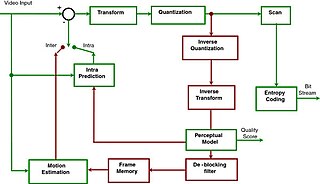Dirac is an open and royalty-free video compression format, specification and software video codec developed by BBC Research & Development. Dirac aimed to provide high-quality video compression for Ultra HDTV and competed with existing formats such as H.264.

Advanced Video Coding (AVC), also referred to as H.264 or MPEG-4 Part 10, is a video compression standard based on block-oriented, motion-compensated coding. It is by far the most commonly used format for the recording, compression, and distribution of video content, used by 91% of video industry developers as of September 2019. It supports a maximum resolution of 8K UHD.
SMPTE 421, informally known as VC-1, is a video coding format. Most of it was initially developed as Microsoft's proprietary video format Windows Media Video 9 in 2003. With some enhancements including the development of a new Advanced Profile, it was officially approved as a SMPTE standard on April 3, 2006. It was primarily marketed as a lower-complexity competitor to the H.264/MPEG-4 AVC standard. After its development, several companies other than Microsoft asserted that they held patents that applied to the technology, including Panasonic, LG Electronics and Samsung Electronics.
x264 is a free and open-source software library and a command-line utility developed by VideoLAN for encoding video streams into the H.264/MPEG-4 AVC video coding format. It is released under the terms of the GNU General Public License.

P2 is a professional digital recording solid-state memory storage media format introduced by Panasonic in 2004. The P2 card is essentially a RAID of Secure Digital (SD) memory cards with an LSI controller tightly packaged in a die-cast PC Card enclosure. The system includes cameras, decks as drop-in replacements for videotape decks, and a special 5.25-inch computer drive for random-access integration with non-linear editing systems (NLE). The cards can also be used directly where a PC card (PCMCIA) slot is available, as in most older notebook computers, as a normal hard disk drive, although a custom software driver must first be loaded.
Α video codec is software or a device that provides encoding and decoding for digital video, and which may or may not include the use of video compression and/or decompression. Most codecs are typically implementations of video coding formats.
AVCHD is a file-based format for the digital recording and playback of high-definition video. It is H.264 and Dolby AC-3 packaged into the MPEG transport stream, with a set of constraints designed around the camcorders.
The first attempt at producing pre-recorded HDTV media was a scarce Japanese analog MUSE-encoded laser disc which is no longer produced.
The following is a list of H.264/MPEG-4 AVC products and implementations.

VP8 is an open and royalty-free video compression format released by On2 Technologies in 2008.
High Efficiency Video Coding (HEVC), also known as H.265 and MPEG-H Part 2, is a video compression standard designed as part of the MPEG-H project as a successor to the widely used Advanced Video Coding. In comparison to AVC, HEVC offers from 25% to 50% better data compression at the same level of video quality, or substantially improved video quality at the same bit rate. It supports resolutions up to 8192×4320, including 8K UHD, and unlike the primarily 8-bit AVC, HEVC's higher fidelity Main 10 profile has been incorporated into nearly all supporting hardware.

x265 is an encoder for creating digital video streams in the High Efficiency Video Coding (HEVC/H.265) video compression format developed by the Joint Collaborative Team on Video Coding (JCT-VC). It is available as a command-line app or a software library, under the terms of GNU General Public License (GPL) version 2 or later; however, customers may request a commercial license.
Intel Quick Sync Video is Intel's brand for its dedicated video encoding and decoding hardware core. Quick Sync was introduced with the Sandy Bridge CPU microarchitecture on 9 January 2011 and has been found on the die of Intel CPUs ever since.
A video coding format is a content representation format of digital video content, such as in a data file or bitstream. It typically uses a standardized video compression algorithm, most commonly based on discrete cosine transform (DCT) coding and motion compensation. A specific software, firmware, or hardware implementation capable of compression or decompression in a specific video coding format is called a video codec.
XAVC is a recording format that was introduced by Sony on October 30, 2012. XAVC is a format that will be licensed to companies that want to make XAVC products.

VP9 is an open and royalty-free video coding format developed by Google.
Apple ProRes is a high quality, "visually lossless" lossy video compression format developed by Apple Inc. for use in post-production that supports video resolution up to 8K. It is the successor of the Apple Intermediate Codec and was introduced in 2007 with Final Cut Studio 2. Much like the H.26x and MPEG standards, the ProRes family of codecs use compression algorithms based on the discrete cosine transform (DCT). ProRes is widely used as a final format delivery method for HD broadcast files in commercials, features, Blu-ray and streaming.
High Efficiency Video Coding implementations and products covers the implementations and products of High Efficiency Video Coding (HEVC).
AOMedia Video 1 (AV1) is an open, royalty-free video coding format initially designed for video transmissions over the Internet. It was developed as a successor to VP9 by the Alliance for Open Media (AOMedia), a consortium founded in 2015 that includes semiconductor firms, video on demand providers, video content producers, software development companies and web browser vendors. The AV1 bitstream specification includes a reference video codec. In 2018, Facebook conducted testing that approximated real-world conditions, and the AV1 reference encoder achieved 34%, 46.2%, and 50.3% higher data compression than libvpx-vp9, x264 High profile, and x264 Main profile respectively.




